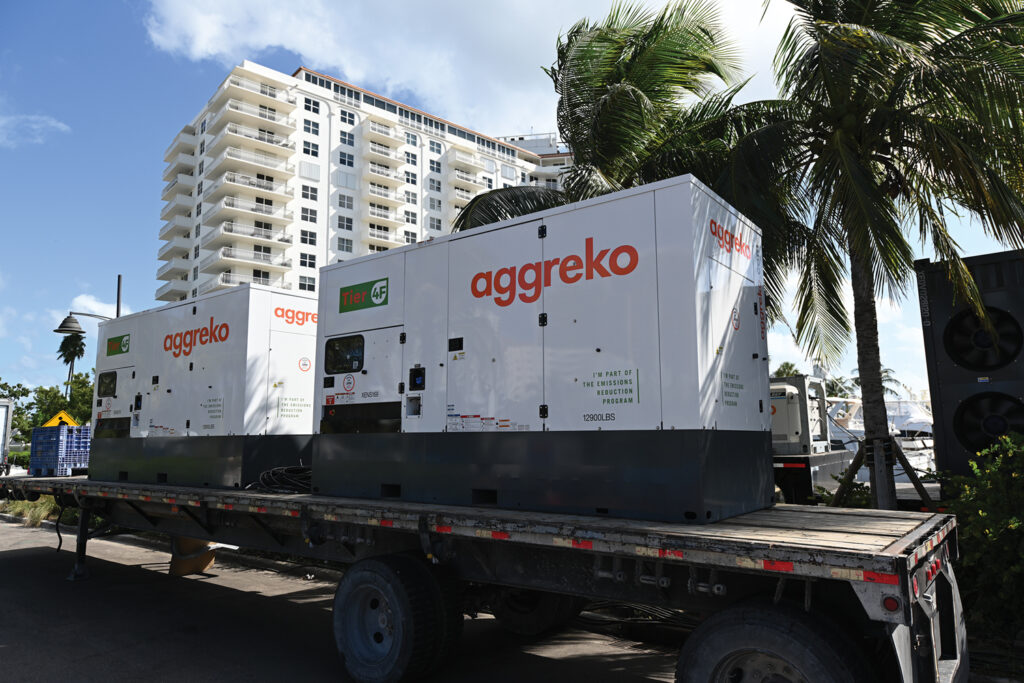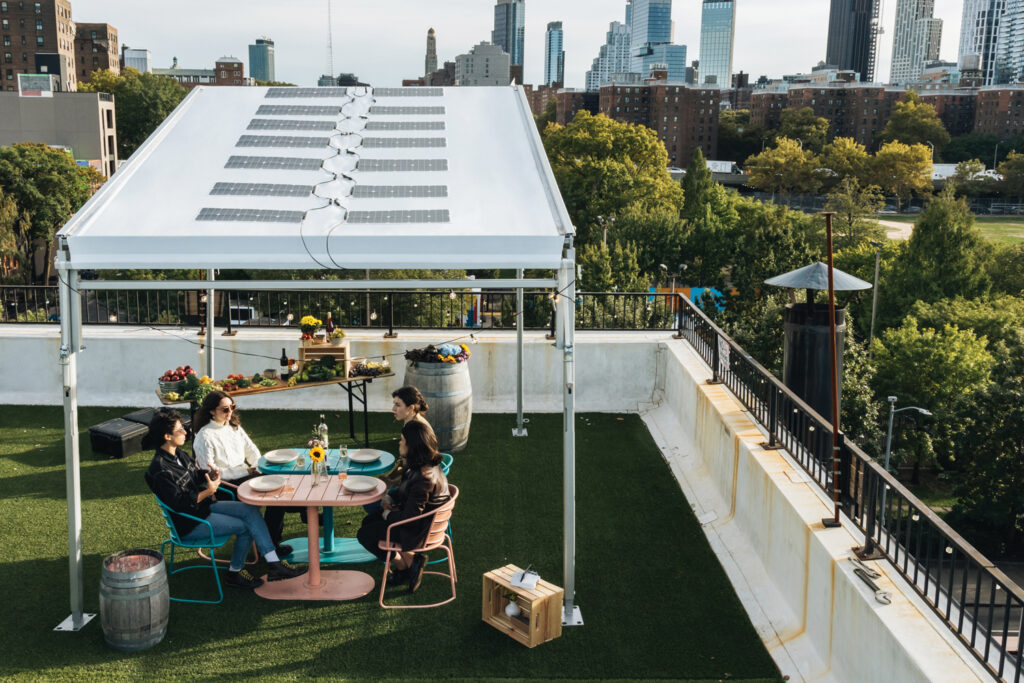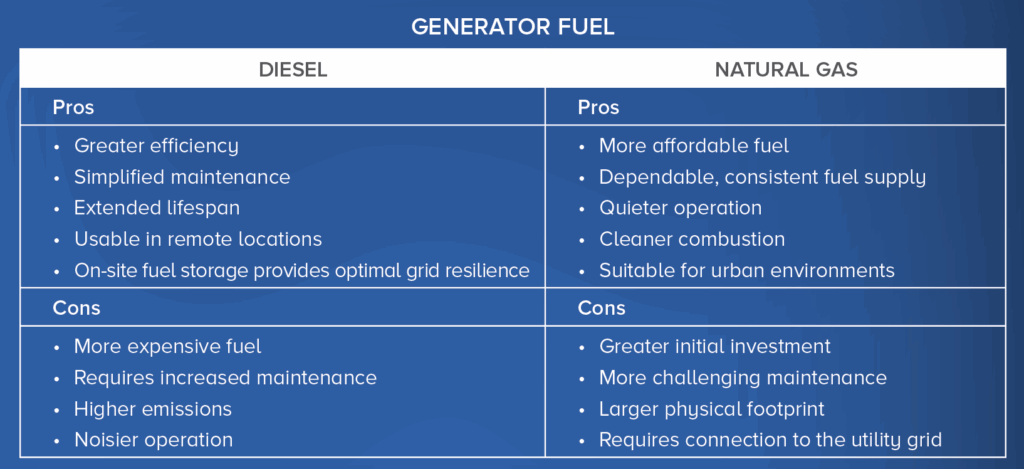
From selecting the appropriate generator size and evaluating its environmental impact to ensuring safe installation, providing the electricity needed for lighting, sound, entertainment and culinary needs at outdoor events requires an in-depth understanding of the nuances involved.
Size matters
When most people think about power, they may assume “more is better.” After all, what could possibly go wrong with having too much power? Isn’t that better than not having enough?
As it turns out, having “just enough” power, also known as “rightsizing,” is a crucial aspect of optimizing power provision for a site, event or project. According to Daryl Benz, national event specialist at Aggreko, a company that offers rental solutions for power generation, rightsizing involves matching the power generation capacity with the specific power demands, aiming to create efficiency gains.
“Regardless of industry or how small or large the power requirement, rightsizing is essential to minimizing fuel use, emissions and maximizing efficiency,” Benz says.
Oversizing generators can impact operations in several ways. As Benz explains, generators do not perform well at low loads, leading to inefficiency, performance issues, fuel wastage and potential breakdowns. Inefficiency can also lead to additional emissions and pollutants.
Steve McGhee, president of Sunbelt Rentals Power & HVAC (previously Special Event Service & Rental), Broomfield, Colo., says he frequently sees issues with selecting the correct generator size. “We find that an overwhelming majority of generators are significantly oversized for the application. This leads to increased fuel consumption, additional service and maintenance, as well as reliability issues,” he says. “If the generator is sized too large for the required power load, the engine will not burn the fuel clean, which causes soot to build up in some engine components and the exhaust system. This inhibits proper operation of the generator.”
It is equally important to not undersize the generator. In most event applications, the electrical load is not constant; the load increases as more power is needed, such as air conditioners cycling on as the day heats up, or lighting load increases for an evening concert. If all of these needs were not taken into consideration, it could lead to a sudden power failure.

Safety measures
The sizing of the generator and installing the power components safely go hand in hand. Some of the biggest issues that arise with the use of power at events include not using the proper cable and power distribution, improper grounding of the generator, and not protecting and covering the cable in public areas.
“Safety should be the first thing someone thinks of when they start running out cable and distributing power,” Benz says. “For example, if you have a 100-kilowatt generator set at 120/208 volts and run 2/5 banded cable from the generator out to a distribution panel, that cable is not protected and could burn up if there is a fault along the line. A 100 kilowatt has a 400-amp breaker but the cable is only rated for 150 amps. Your power source should always dictate what size and quantity of cable you need to run out.”
McGhee points out that each type and size of cable has a different capacity and rating. It is important to use the correct equipment for the project at hand, including the correct power distribution panels as well as the correct breakers in the panels. Also, the use of ground fault circuit interrupters on all receptacles is required by code.
“Sometimes a generator may be upsized due to availability at the time of the order, but the cable is not corrected,” Benz says. “For any outdoor event, any outlet that the public can get to and plug in something should be ground fault protected. This will protect the general public in case of rain or any moisture that might be near these power outlets.”
Of course, proper placement of a generator is also important. The layout of every event site is different, as some sites are quite tight, requiring the generator to be closer than is preferred to the structure and other components of an event. In addition, covering the generator for aesthetic reasons also can be problematic. When covering generators, provide a few feet of space around the unit so there is no constriction of the air needed to cool the unit.
“Always allow ample room to service and refuel the generator,” McGhee says. “Also, if you block the generator in where it cannot easily be replaced, it’s a good idea to place a backup generator as well. Always refer to local code enforcement and fire inspector when in question.”

Powering through extremes
When it comes to generators and changing weather conditions, there are concerns with generators being used in extremely hot or cold weather. Benz says that when you get into extreme hot weather conditions, the capacity of a generator will decrease due to the high temps. Once the load increases, it will not be able to expel the heat from the engine through the radiator because there will be hot air crossing the coils. The opposite happens when in extreme cold weather.
In cold environments, power-source providers use diesel exhaust fluid (DEF), a mixture of 32.5% urea and 67.5% deionized water, to keep generators in working condition. DEF’s freezing point is 12 F, so precautions should be taken in extreme cold weather to prevent it from freezing and bursting the reservoir. The recommended precaution is to not totally fill the tank to leave room
for expansion.
Internal tanks are usually heated to keep DEF from freezing. Any external tank also should have heating elements to keep DEF from freezing in the tanks. If needed, the external DEF fuel line can be wrapped and insulated to prevent freezing.

Solar-power generation
The event industry continues to “go green” throughout all facets of event production, including considering alternative sources of power such as solar. Colin Touhey, CEO of Pvilion, a Brooklyn, NY-based company that designs, engineers, manufactures and installs flexible solar-powered fabric structures, is seeing a growing demand for solar power
at events.
“Not only are sustainability initiatives increasing within the event industry, but folks are starting to recognize the other benefits of transitioning away from diesel generators,” Touhey says. “Everyone knows that generators are loud. Not only that, but they emit fumes that are terrible for the environment and the health of those that inhale them. Meanwhile, solar-powered batteries are silent, release zero exhaust and are overall better for the planet.”
Now that solar panels can be used in lightweight, flexible and mobile applications, this technology is becoming much more accessible for the event space. In fact, the band Coldplay used Pvilion Solar Fabric kits on its recent world tour.
“These products basically replace any instance where a generator would be needed,” Touhey says. “They can provide enough power to replace 5-kilowatt, 25-kilowatt or even 50-kilowatt generators.”
The solar panels used in Pvilion’s products are the same monocrystalline cells used in a traditional glass panel. The only difference is that Pvilion integrates that cell with fabric instead of a glass casing. Unlike traditional glass solar panels, the solar-powered fabric can survive hailstorms, falling debris and being dropped without shattering.
As cliche as it may sound, Touhey says the possibilities for this technology really are endless. “We believe that any area that receives sunlight is an opportunity for solar fabric. Right now, rooftops are one of the most common spaces for solar panels, but we believe that soon it will be standard to integrate solar fabric into mobile applications
as well.”

Battery-bank systems
With emerging battery technologies and lower costs to consumers, battery energy storage systems (BESS), also referred to as battery bank systems, are being more widely integrated into temporary power solutions. Batteries may not be suitable for every situation, but key characteristics can significantly enhance the value of BESS when present.
“Noise and exhaust can be viewed as a hazard and a nuisance, depending on the application. The solution is to either place the generator further away or limit the amount of time it runs,” says McGhee. “In some applications, we like to pair our generators with a BESS, as this allows us to control the time that the generator runs. For example, we can charge the batteries during off hours of the event and the batteries can carry the load silently with no exhaust fumes to worry about during active periods of the event.”
Whether in a stand-alone application, paired in a hybrid setup with a generator or paralleled in a micro-grid, they bring solutions to customers that traditional generators alone cannot deliver.
“Battery systems are the way of the future,” McGhee says. “They will never replace the diesel generator; however, working in conjunction with generators and other technology, the BESS units are becoming a real solution for many applications both in events as well as commercial and industrial. BESS units have brought significant benefits to the event world over the last couple of years. We are discovering new applications for them on a regular basis.”
Maura Keller is a freelance writer based in Minneapolis, Minn.
SIDEBAR: Diesel or natural gas?
While diesel and natural gas are the two most commonly used fuel types for industrial-class generators, each has its advantages and disadvantages. Daryl Benz, national event specialist at Aggreko, says there isn’t a universal solution for determining which is superior, as both provide dependable power while being more environmentally friendly than ever.
Benz points to the following considerations for customers to review before deciding on which is more suitable for their generator application:

For portable generators, diesel generally offers greater power output, longer runtimes and higher fuel efficiency, making it better suited for situations requiring continuous, larger power needs.
“For the event industry, diesel seems to be the more practical option,” Steve McGhee, president of Sunbelt Rentals Power & HVAC says. “Natural gas or propane generators do have many pros. They burn cleaner and can be a great solution in small applications where fuel logistics and replacing tanks or refilling tanks on-site don’t become too cumbersome. Natural gas can also be used on very large, more long-term projects. Fuel logistics still seems to be the largest obstacle for use in the entertainment industry.”
 TEXTILES.ORG
TEXTILES.ORG


